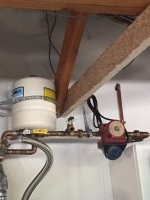ellamas
New Member
Hello,
Hot water would take over two mins to come out of kitchen and master bath faucet. I knew I had a couple options for installing a recirc. system. I considered installing a pump at the HW discharge with under sink T valves, but ultimately decided against since I was adamant on not having hot water push into my cold water line. I realized it would be very minimal but I'm a bit particular about the way I want things. Due to my hard requirements, at times I am faced with having to do additional work to get it "just right." Please see below on where I need some help please.
I decided to go with installing a dedicated return line from the furthest (or what i thought) fixture, and pump the water into the cold water side of the water heater. I did research on this and installed all the proper valves and fittings. Please referencing the attached pics. I chose the master bath as the furthest fixture and ran a 1/2" soft copper L line to the pump in the garage, which again pumps into the cold water side. I installed check valves and the master bath has instant hot water - works perfectly!
The bad news is the kitchen sink saw minimal to no improvement. My home is a slab foundation therefore didn't know exactly how the plumbing lines ran. Probably could have had a plumber trace the lines with a fancy tool, but I of course didn't do that, so here I am.
My thoughts now is to run a second return line from the kitchen sink and Tee at the inlet of the pump. Pls see pics. Running the line will not be so fun but know it can be done. My main concern is doing all this work and system still doesn't function as expected. Did some research but unsure if I could simply tee both return lines at the pump inlet or if I need to install some flow control valves, so that I can modulate the flow of each return line. My concern is if I simply tee what if more water will flow from master bath return line vs kitchen return line, or vice versa. At this point, I really need to be 99.9% sure that this will work as I'm sure everyone can appreciate that running the return line to the kitchen sink (with window above) will take some effort. If I can simply tee without any additional valves then all the better
Did talk to a plumber and he at first said to install the T valve under the kitchen sink, but I don't see how that would work since in my application the pump is pumping into the WH vs. for a pump system with T valves the pump is installed on the hot water discharge.
I appreciate any help and recommendations.
Thank you.
Hot water would take over two mins to come out of kitchen and master bath faucet. I knew I had a couple options for installing a recirc. system. I considered installing a pump at the HW discharge with under sink T valves, but ultimately decided against since I was adamant on not having hot water push into my cold water line. I realized it would be very minimal but I'm a bit particular about the way I want things. Due to my hard requirements, at times I am faced with having to do additional work to get it "just right." Please see below on where I need some help please.
I decided to go with installing a dedicated return line from the furthest (or what i thought) fixture, and pump the water into the cold water side of the water heater. I did research on this and installed all the proper valves and fittings. Please referencing the attached pics. I chose the master bath as the furthest fixture and ran a 1/2" soft copper L line to the pump in the garage, which again pumps into the cold water side. I installed check valves and the master bath has instant hot water - works perfectly!
The bad news is the kitchen sink saw minimal to no improvement. My home is a slab foundation therefore didn't know exactly how the plumbing lines ran. Probably could have had a plumber trace the lines with a fancy tool, but I of course didn't do that, so here I am.
My thoughts now is to run a second return line from the kitchen sink and Tee at the inlet of the pump. Pls see pics. Running the line will not be so fun but know it can be done. My main concern is doing all this work and system still doesn't function as expected. Did some research but unsure if I could simply tee both return lines at the pump inlet or if I need to install some flow control valves, so that I can modulate the flow of each return line. My concern is if I simply tee what if more water will flow from master bath return line vs kitchen return line, or vice versa. At this point, I really need to be 99.9% sure that this will work as I'm sure everyone can appreciate that running the return line to the kitchen sink (with window above) will take some effort. If I can simply tee without any additional valves then all the better
Did talk to a plumber and he at first said to install the T valve under the kitchen sink, but I don't see how that would work since in my application the pump is pumping into the WH vs. for a pump system with T valves the pump is installed on the hot water discharge.
I appreciate any help and recommendations.
Thank you.
Attachments
Last edited:

